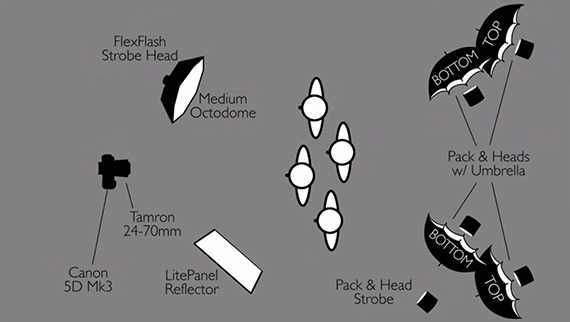Whether you’re producing photos for books, fashion catalogs, product pages, multimedia, or any other use, it’s important to understand how to capture a great photo on a pure white background. Although at first glance working with a pure white background may seem easy, that’s far from the case. While you may not be working on as large a scale as 40 different setups in a day, the planning lessons are just as important as the lighting tips in this tutorial:
There are two important aspects to remember when working with a white background: planning and lighting. When working with a crew, move from set to set to set. This allows you to keep moving forward, while your crew goes in behind you to create the next setup.
The lighting for your photo shoot can change depending upon your overall look. However, the important thing is to understand the principle of controlling your light. If you just slap your lights up without putting any thought or consideration into them, it can create a variety of unwanted effects in your photos.
To help provide a nice, solid white background without taking up too much real estate, Jay P. Morgan uses two lighting sets of two. He places each tree (lighting set created using one light on a stand and a second light using a Bogen clamp) on each side of the white background, creating two heads per tree. The top head on each of the trees is angled toward the background and slightly down, with the bottom lights focusing on the middle and slightly down. Be careful of turning it too much as you don’t want to spill the lighting onto the person in the foreground.
Using a meter, Morgan creates his setup using an f/16 aperture for the background and f/11 for the subject. While these settings may not work for every setup, the overall goal is to have your background one stop brighter than your subject.

Lighting setup: 4 heads for background, and key light & reflector for foreground
To finish off his setup, Morgan uses a nice rim light from the right side of the camera and a key light from upfront. Depending upon the overall design, you can play around with the lighting a bit. For instance, for Morgan’s boxing setup, he uses a heavy rim light from behind with a small softbox above it to open up the shadows.
White backgrounds are great for removing distractions from your photography. While it may not be the easiest background to work with, once you have mastered white backgrounds they can be a lot of fun to work with. As with any new aspect in your photography, practice makes perfect, so keep clicking away and working with your lighting setup until you have mastered the lighting principles for working with a white background.
Like This Article?
Don't Miss The Next One!
Join over 100,000 photographers of all experience levels who receive our free photography tips and articles to stay current:







Leave a Reply